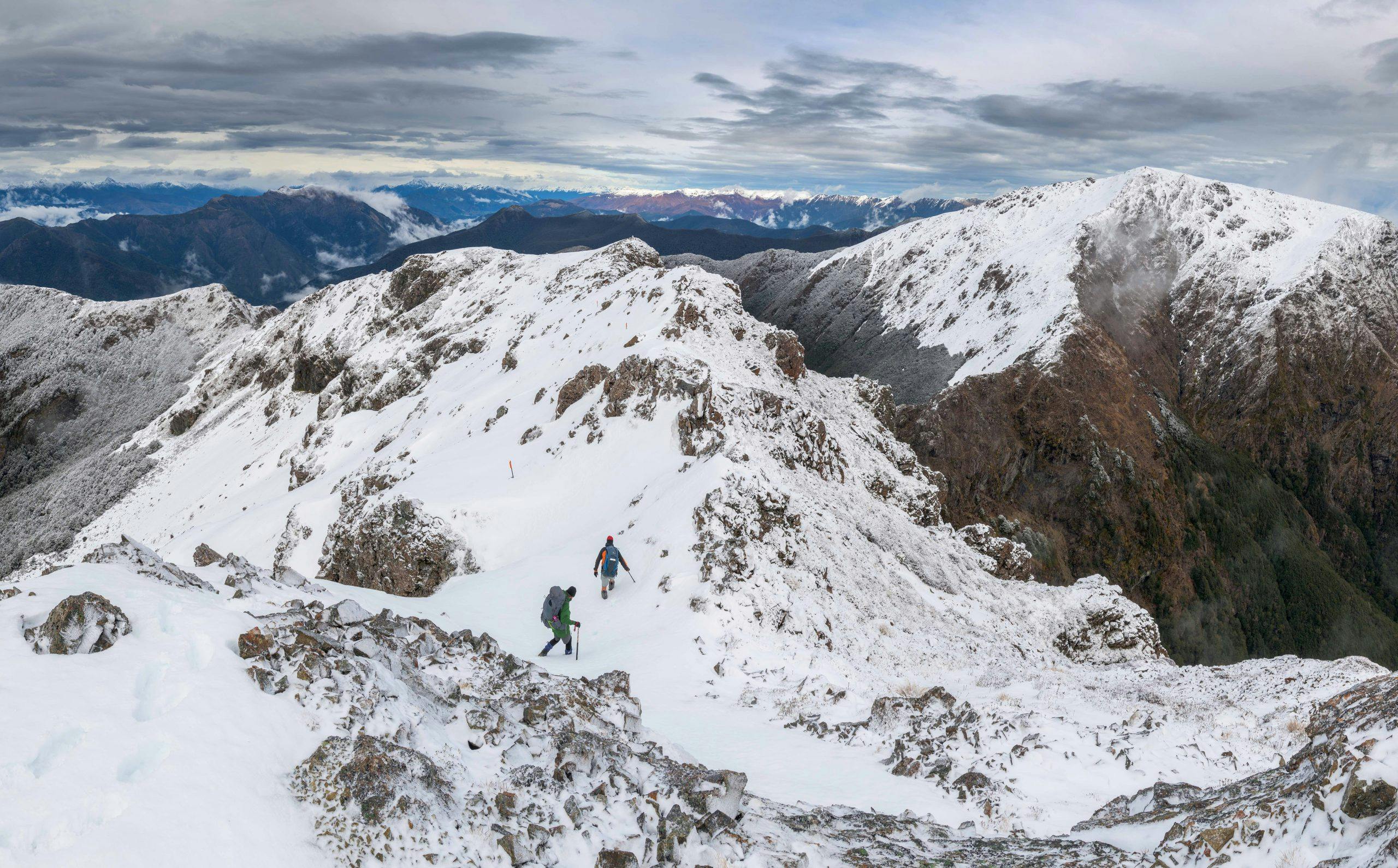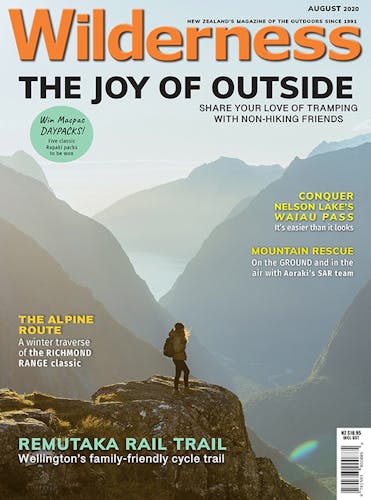Shaun Barnett and the Richmond Range Appreciation Society complete a winter traverse of the Alpine Route
To mark Wilderness magazine’s 30th anniversary, current and past editors and contributors scoured the archives for the 30 best trips we’ve published over the decades. This story, original published in August 2020, was included. You can find all 30 of the greatest Wilderness trips in the October 2021 issue.
When the Richmond Range Appreciation Society set off on its inaugural tramp over the Alpine Route last winter, only one of the three trampers – me – could claim full membership.
The five-day route has much to commend it – a satisfying tramp around a horseshoe of island-like peaks, protruding above a sea of beech forest; tidy huts with ample firewood; no major river crossings and enough variety and ruggedness to satisfy most. As a student, I’d often tramped in the Richmond Range, sometimes because it was our destination of choice; and at other times because of poor weather or avalanche danger elsewhere in the South Island mountains.
The second member of our party, Peter Laurenson, was keen to sample this range which was previously unknown to him. However, the third, Nelson born and bred Robbie Burton, publisher at Potton and Burton, had spent most of his 60 years studiously ignoring the range closest to his backdoor.
Admittedly, Nelsonians are spoilt for choice and Robbie has tramped in Kahurangi (our second-largest national park), Abel Tasman (arguably the prettiest), and Nelson Lakes (the northernmost mountains of the Southern Alps).
If not for a poor forecast that scuttled our A-Plan for a climb in the Southern Alps, Peter and I may not have convinced Robbie to chance the Alpine Route at all.
But here we were, tackling our B-Plan, beginning from the Aniseed Road car park. Pine forest dominates the track as far as Hacket Hut, which was in pleasingly good condition for one so close to the road-end.
Markers led up the Hacket Stream, which we crossed in places, en route passing a sun-dappled pool of exquisite blue-green. From here, the Alpine Route climbs high, and stays high for several days, before it ends in the Wairoa Valley. The steep track past Pyramid Rock tested lungs and backs not used to six-day packs. While Peter strode ahead, Robbie and I plodded, knowing we had daylight enough to reach Starveall Hut.
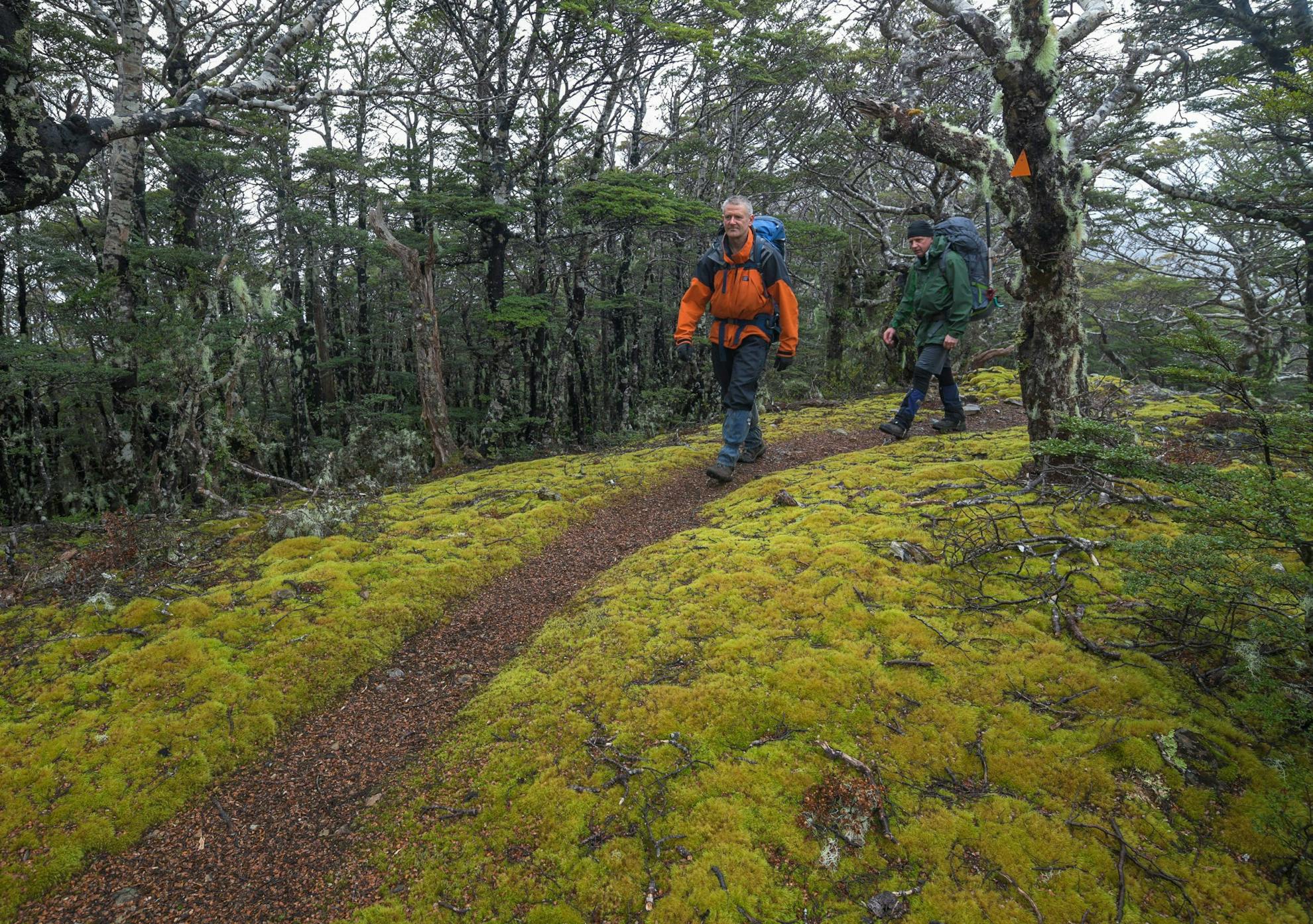
When I first walked the Alpine Route more than 30 years ago, there were two huts at Starveall; an older smaller one, now long gone, and the Forest Service six-bunker that still remains.
Recently repainted, it was in beautiful condition.
One of the Alpine Route’s delights is that the huts are all perched near the bushline, meaning plenty of firewood. We gathered enough to fill the woodshed.
Towards evening, Peter explored Mt Starveall while I went only as far as the first knoll. The weather was already turning, with westerly cloud building. A curl of smoke from the hut chimney promised a warm interior.
Over the course of the tramp, Robbie proved to be a firewood master – skills dating back to his 1980 Southern Alps traverse with Craig Potton. He told us of a sodden camp on Ruth Flat where they managed to kindle a fire despite the rain. Into the blaze they fed great logs, creating a pyre so fierce that it simply evaporated raindrops.
Thirty years ago, local trampers regarded the Richmond Range as their best-kept secret and the Alpine Route as its centrepiece. It’s now part of Te Araroa, tackled by a steadily growing number of thru-hikers from all over the world. As the annual tide of Te Araroa hikers washes through in summer and autumn, the huts are usually full.
However, locals can still enjoy the quieter seasons. We met no one else. And, impressively, the local DOC rangers have retained the low-key flavour of the trail. All of the huts are well maintained, with just minor concessions to increased use. For example, all have picnic tables for campers to cook on. That struck me as an unobtrusive, cost-effective way of increasing capacity without resorting to replacing the small huts with larger structures. After all, most Te Araroa hikers carry a tent. The track is certainly much better marked than 30 years ago and there’s little chance of coming astray in the mist, as we did on my first trip.
In the morning, westerly cloud had swept over the Alpine Route and we found ourselves in murk. No matter; we enjoyed a lazy start. After the initial climb across scree slopes, we struck some delightful travel – mountain neinei rattling its stiff leaves in the breeze, vegetable sheep clumped over rocky knolls, and last summer’s mountain daisies now brown and dried like a flower arrangement. Among spindly mountain beech trees cowed by the altitude, we followed the wending path, leaf-laden and moss-lined. While the area shares similarities with other alpine areas, somehow it has its own indefinable character. Having time to appreciate its textures and colours left me feeling deeply content.
On the south-facing slopes, we struck snow, quilted in patches among the protruding tussocks. Slaty Hut proved cold at first, but gathering and sawing firewood soon warmed us, with the added promise of its latent heat. Although it was just past noon, there was no question of forging on.
While outside the rain lashed in sudden squalls, inside we discussed books and writers around the woodstove. Such warmth and enjoyment amid an otherwise hostile environment seemed absurdly exquisite.
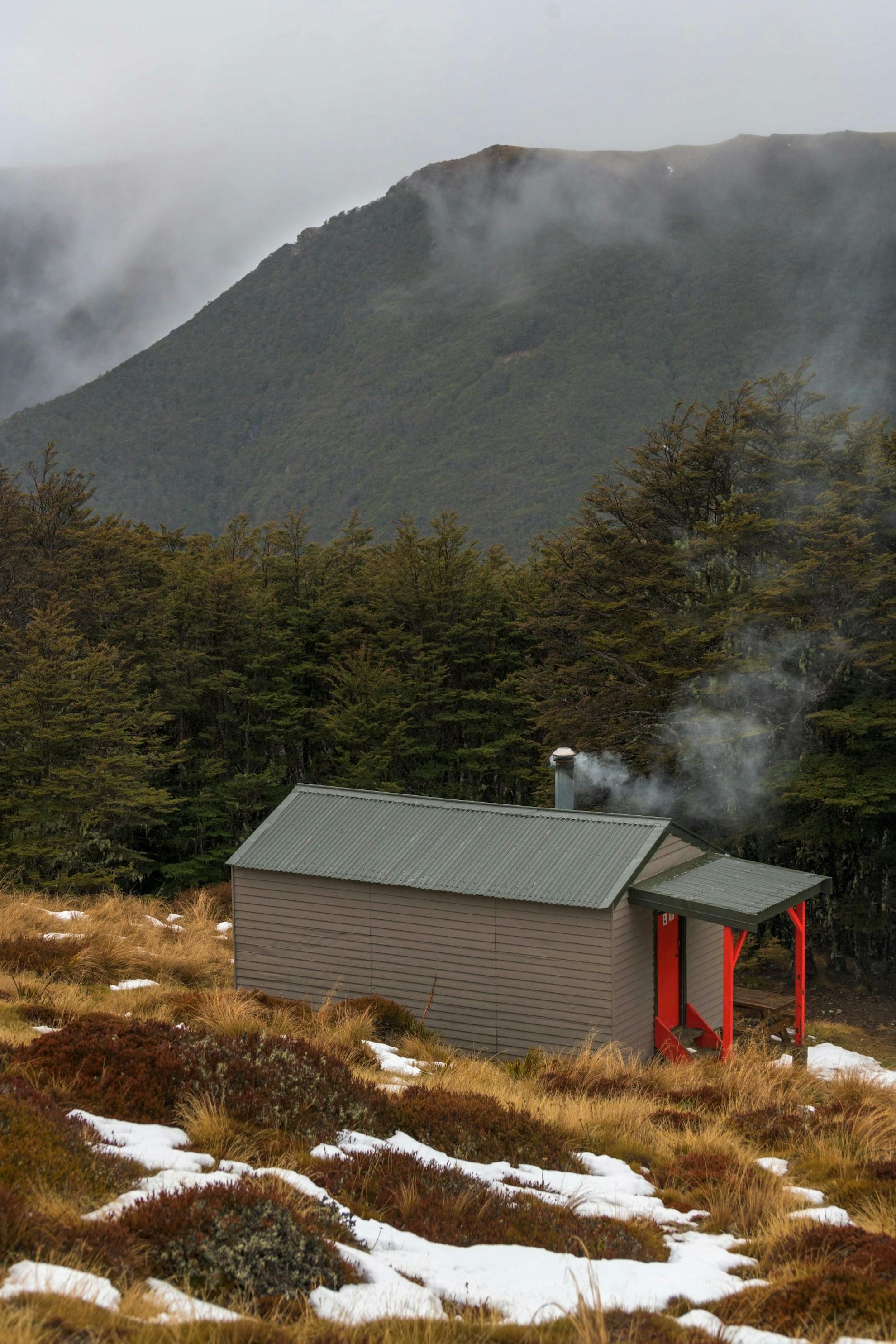
Mist tendrils stroked the ridges as we set off for Old Man, or perhaps beyond to Rintoul. The horseshoe nature of the route means your destination lies deceptively close, just across the valley, and the craggy profiles of Little Rintoul and Rintoul pierced the gloom.
Sometimes you have to give thanks for claggy weather, as it focuses your eyes on what lies beneath: a mosaic of russet-red Dracophyllum, wispy green lichens, bone-white Celmisia stalks, and the ever-present yellow of the tussocks. Blocks of schist, sometimes stacked like plates, gave the appearance of cairns, although they were entirely natural. Despite the weather, the Richmond Range was beginning to exert its charms on Robbie. “This is extraordinary,” he remarked. “I’m loving it.”
The rain held off. Marked by poles, the route weaved through undulating terrain, among snowdrifts, before a descent onto a forested saddle, then onto the easy tops of Ada Flat. Beyond, we suddenly found ourselves on a surprisingly rugged knoll, with cliffs disappearing below into mist. Flocks of brown creepers chattered among the stunted beech trees, and a herd of goats clattered over schist slopes.
With the summit of Old Man behind us, we reached a track junction. On to Rintoul, or down to Old Man Hut? Drizzle arrived, and made our decision: down we tramped to the small, five-bunk hut, set in a pleasant beech-fringed clearing. While bellbirds sang, a weka stalked around.
As we pulled our packs inside, the drizzle grew to fat raindrops. “Perfect timing,” remarked Peter.
Under the percussion of heavy rain on the tin roof, we stoked the fire, read, chatted and cooked our evening meal. For the umpteenth time, I felt grateful for the huts, conscious that they often make the difference between comfort and privation.
Sometime in the night, the rain stopped to be replaced by an eerie quiet. The morning revealed fresh snow draping the tops and reaching well into the forest. By sheer fluke, we had a good day for the most rugged part of the tramp – an exposed crossing of Little Rintoul and Mt Rintoul.
As we climbed through the dwindling beech forest towards Little Rintoul, melting snow dripped on our heads. On the bushedge, we pulled on crampons. As we climbed, the view unfolded. Now, the Alpine Route was an archipelago of gleaming white islands, while beyond rose the higher peaks of Mts Richmond, the Red Hills, and the Kaikoura mountains. Robbie looked toward familiar ranges, but from the fresh vantage point offered by this country new to him. Peter was stoked. Here we could have a truly alpine experience, making amends for the loss of the A-Plan climb. As for me, a long absence had only increased my appreciation.
The sun struggled to emerge through high clouds, and a chill breeze meant we had to keep moving to stay warm. We scrambled up a rocky wall and negotiated a narrow, broken section of ridge onto the summit of Little Rintoul. Crags prevent a direct traverse of the ridge crest, so the route leads steeply down a gully, almost as far as the bushline, into the gap between the twin mountains. Clinging to snow-plastered scrub to get past a rock step underscored just how rugged the terrain was.
Ahead lay a straightforward, if lung-taxing, 250m climb to Mt Rintoul. Peter led strongly, plugging steps in the snow onto the 1731m summit – the highest point on the Alpine Route. Its long, flat summit gives the mountain a shape not unlike a giant anvil.
Beyond, the snow quality varied from breakable crust to deep drifts. Travel in such conditions creates comedy. Like pack-clad snow clowns, we lurched every time an unexpected hole upset our balance.
Avoiding a rocky ridge required a steep descent into a gully, but the snow was firm, and as I led down my crampons bit reassuringly. The final descent to Mt Rintoul Hut entailed a clatter down scree, with our boots scattering stones.
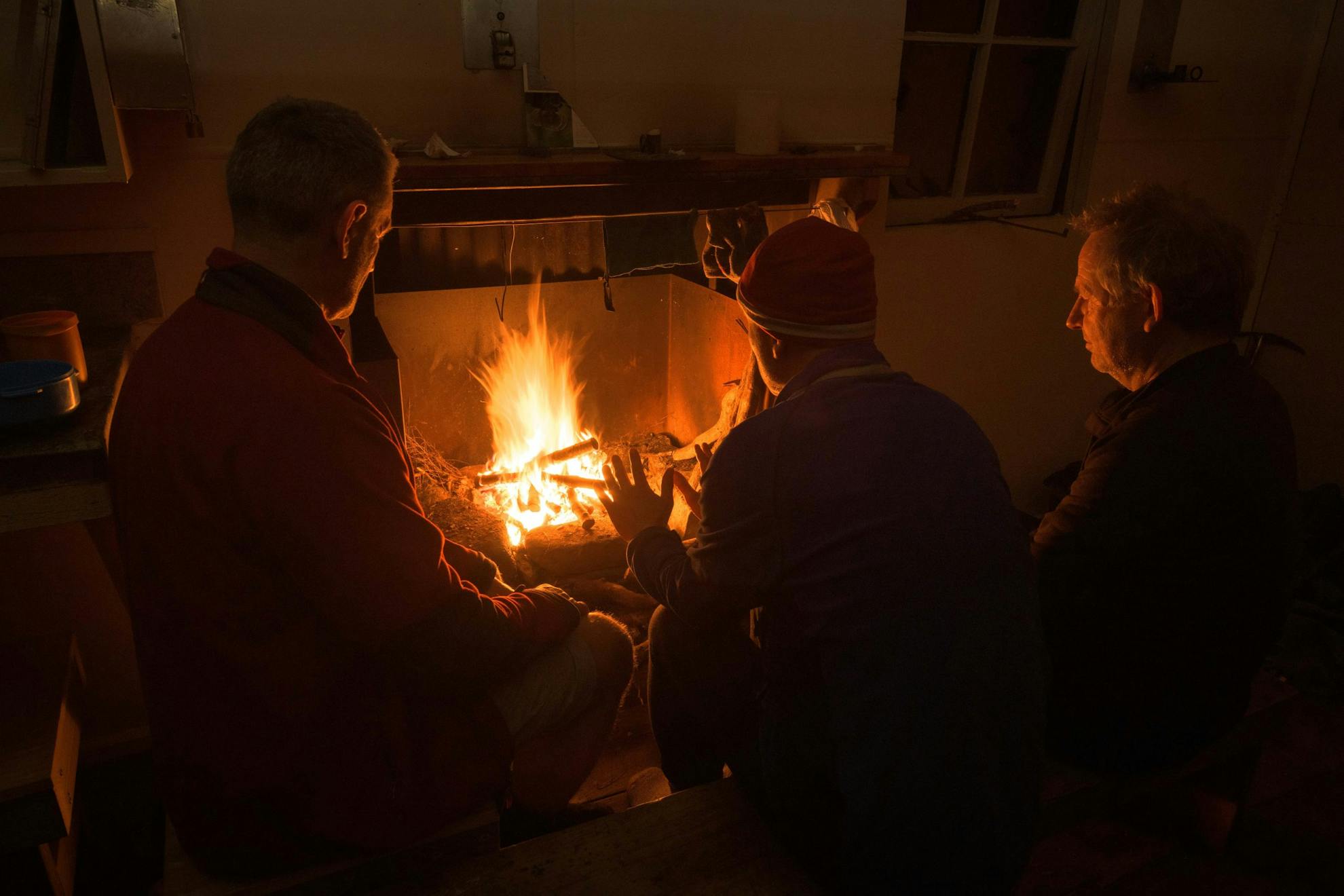
After a day on the snowy tops, Mt Rintoul Hut proved another haven of warmth. That evening, Robbie shared details of his career, which began with producing material for the environmental movement in the 1970s and progressed to publishing The Paparoa Guide by Andy Dennis in the early 1980s. A friendship with Craig Potton led to him becoming the publisher and manager at what is now Potton and Burton, one of the most successful of New Zealand’s independent book publishers. As an author myself, it was sobering to learn of the huge challenges faced by the book trade during the more recent digital revolution and financial crisis of a decade ago.
Talk of publishing seemed curiously relevant, as the name Mt Rintoul originates from Nelson’s colonial days. Captain Wakefield of the New Zealand Company used the mountain as a navigation aid, and renamed it in honour of his friend Robert Rintoul, editor of the London Spectator. While interesting to learn, I couldn’t help but wonder what Māori call the peak – its native name conspicuously absent from maps.
Desultory snowflakes drifted out of the sky, causing me to wonder if my third crossing of Purple Top would be in a blizzard, as the previous two had. Happily, we enjoyed sunshine while crossing it, the last of the peaks on the Alpine Route. Kākā, tomtits, grey warblers and brown creepers kept us company on the bush ridges, before we enjoyed a sun-drenched lunch outside Tarn Hut. Nearby is an unusual, small lake surrounded by forest. Stumps suggest that the tarn is not ancient, but formed by some sort of rockslide that must have dammed a watercourse.
We spent our last night at Mid Wairoa Hut, beside the Wairoa River Left Branch. In some ways, the walk out along the narrow valley track is the most challenging. Narrow, and barely benched at all, it sidles steep country, sometimes above bluffs, and in places requires care over sloping shelves of schist. Below, the river tumbles through some stunningly enclosed constrictions, blue-green and boulder-choked.
The track petered out onto a forestry road, where huge machines had recently been harvesting the pine forest on the steep hillsides. It was sobering to think that without the efforts of people like Robbie and Craig Potton, many more of the forests surrounding Nelson and the West Coast would have looked like this – bare hillsides, swathes of mud, denuded of native forest. After passing the Wairoa Valley Mountain Bike Park, we finally reached the public road.
It may have been our B-Plan, but the Alpine Route is surely a worthy A-Plan.
And so it was that Robbie announced himself as first President of the Richmond Range Appreciation Society.
- Distance
- 54.4km
- Total Ascent
- 4529m
- Time
- 4-5 days. To Hacket Hut, 1.5-2hr; to Starveall Hut, 4-4.5hr; to Slaty Hut, 2.5-3hr. To Old Man Hut, 5hr; to Mt Rintoul Hut, 6-7hr; to Tarn Hut, 5hr; to Mid Wairoa Hut, 2.5-3hr; to Wairoa Gorge Road, 4-5hr
- Access
- Aniseed Valley Road, at Hackett Track trailhead Grade Difficult. Ice axe and crampons essential in winter
- Map
- BQ26, BQ27, BR25, BR26
GPX File
- Alpine Route (gpx, 40 KB)
GPX File
- Your device does not support GPX files. Please try a different device.





